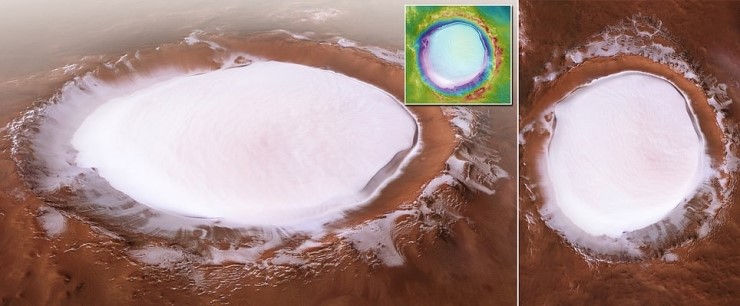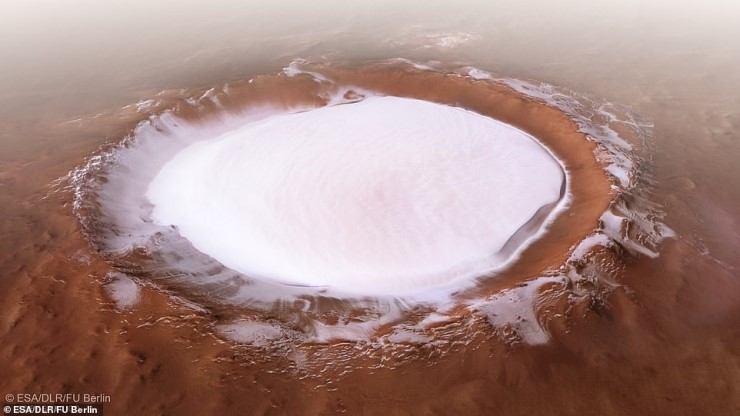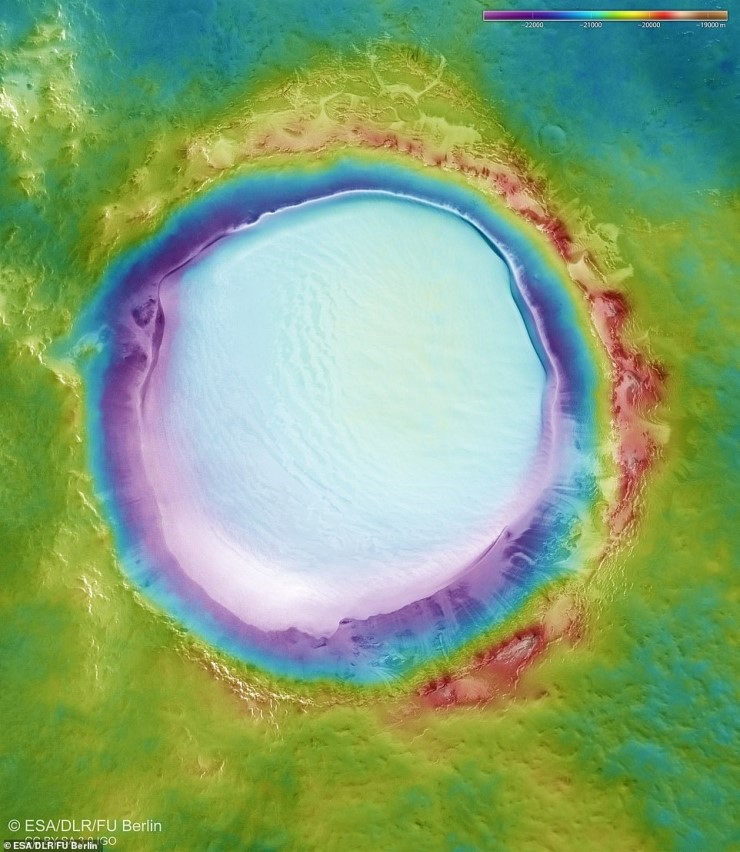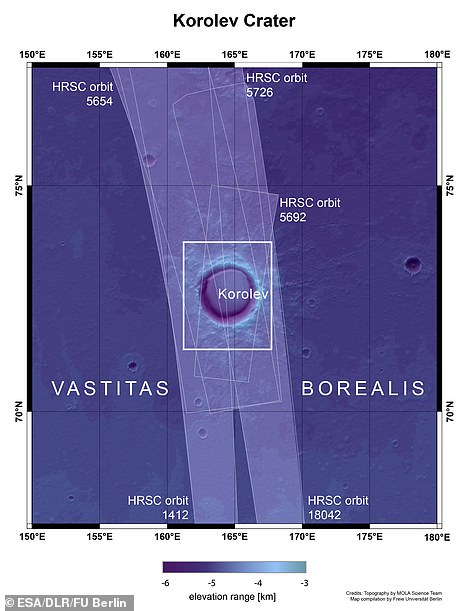화성에 화이트 크리스마스가? VIDEO; Christmas comes to Mars: Stunning images reveal gigantic ice filled crater 50 miles wide on the surface of the red planet
Christmas comes to Mars: Stunning images reveal gigantic ice filled crater 50 miles wide on the surface of the red planet

Korolev crater is a 50 mile (82 km) wide feature in in the northern lowlands of Mars
Its center contains a mound of water ice some 1.1 miles thick all year round
The domed area forms a glacier comprising around 528 cubic miles of non-polar ice
화성에 화이트 크리스마스가? 놀라운 사진들은 붉은 행성의 표면에 82km 넓이의 거대한 얼음으로 채워진 분화구를 보여준다. 이것은 다른 행성에서 온 완벽한 크리스마스 카드 이미지다. 유럽항공우주국의 Mars Express는 이 붉은 행성에 거대한 분화구를 보여주는 믿을 수 없을 만큼 새로운 일련의 사진들을 보여주었다. 화성의 북쪽 저지대에는 폭이 50마일(82km)이나 되는 코롤리프 분화구가 있다. 이 같은 모습은 수직으로 2km 깊이 분화구의 바닥에 자연적 '콜드 트랩'으로 알려진 현상 때문이다. 콜드 트랩 cold trap https://terms.naver.com/entry.nhn?docId=660929&cid=42434&categoryId=42434 |
By MARK PRIGG FOR DAILYMAIL.COM
PUBLISHED: 20:53 GMT, 20 December 2018 | UPDATED: 21:56 GMT, 20 December 2018
It is a picture perfect Christmas card image from another planet.
The European Space Agency's Mars Express has returned an incredible new series of images showing a giant crater on the red planet.
It shows the Korolev crater, a 50 mile (82 km) wide feature in in the northern lowlands of Mars.

The European Space Agency's Mars Express has returned an incredible new series of images showing the Korolev crater, a 50 mile (82 km) wide feature in in the northern lowlands of Mars
WHAT CAUSES THE ICE?
The ever-icy presence is due to a phenomenon known as a 'cold trap' caused by the crater's floor lying two kilometres vertically beneath its rim.
The very deepest parts of Korolev crater act as a natural cold trap.
The air moving over the deposit of ice cools down and sinks, creating a layer of cold air that sits directly above the ice itself.
Acting as a shield, this layer helps the ice remain stable and stops it from heating up and disappearing.
Just south of a large patch of dune-filled terrain that encircles part of the planet's northern polar cap (known as Olympia Undae), ESA says it is 'an especially well-preserved example of a martian crater.'
It is filled not by snow but ice, with its center hosting a mound of water ice some 1.8 kilometres thick all year round.

Colour-coded topographical image map of the Korolev Crater: The image strips acquired from different angles by the HRSC camera system on board Mars Express are used to generate digital terrain models of the Martian surface, containing height information for each recorded pixel. The colour coding of the digital terrain model (top right) indicates the elevation differences effectively: the topographical profile of the region covers approximately 3500 metres of elevation.
This domed deposit forms a glacier comprising around 528 cubic miles of non-polar ice on Mars.
Smaller amounts of water ice are distributed on and around the crater edge in the form of thin layers of frost.
This ever-icy presence is due to a phenomenon known as a 'cold trap' caused by the crater's floor lying two kilometres vertically beneath its rim.
The very deepest parts of Korolev crater, those containing ice, act as a natural cold trap: the air moving over the deposit of ice cools down and sinks, creating a layer of cold air that sits directly above the ice itself.

Taken by the Mars Express High Resolution Stereo Camera (HRSC), this
view of Korolev crater comprises five different 'strips' that have been combined
to form a single image, with each strip gathered over a different orbit.
Acting as a shield, this layer helps the ice remain stable and stops it from heating up and disappearing.
Air is a poor conductor of heat, exacerbating this effect and keeping Korolev crater permanently icy.
Taken by the Mars Express High Resolution Stereo Camera (HRSC), this view of Korolev crater comprises five different 'strips' that have been combined to form a single image, with each strip gathered over a different orbit.
kcontents








